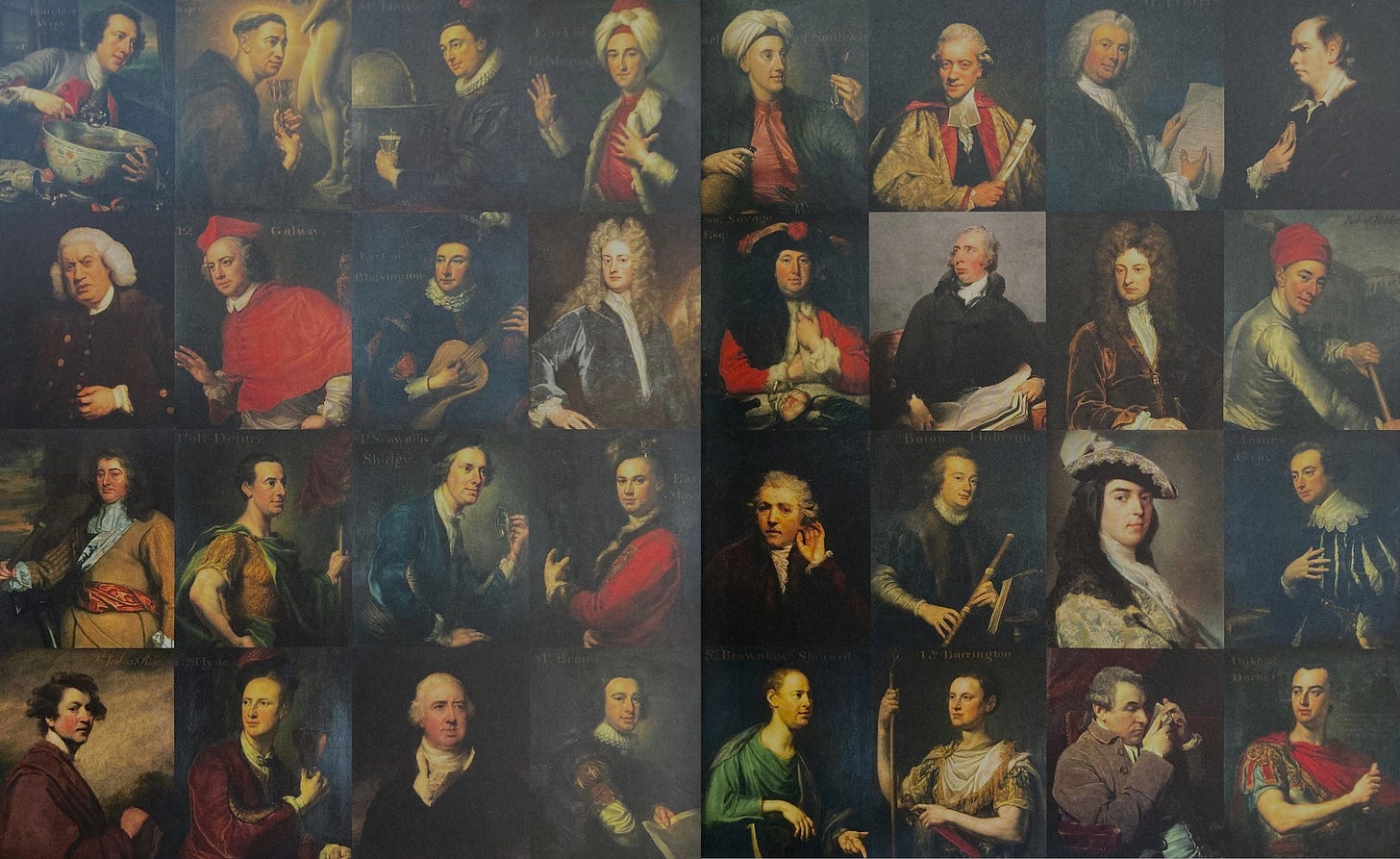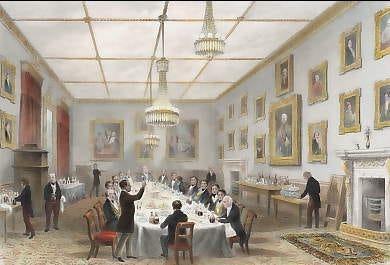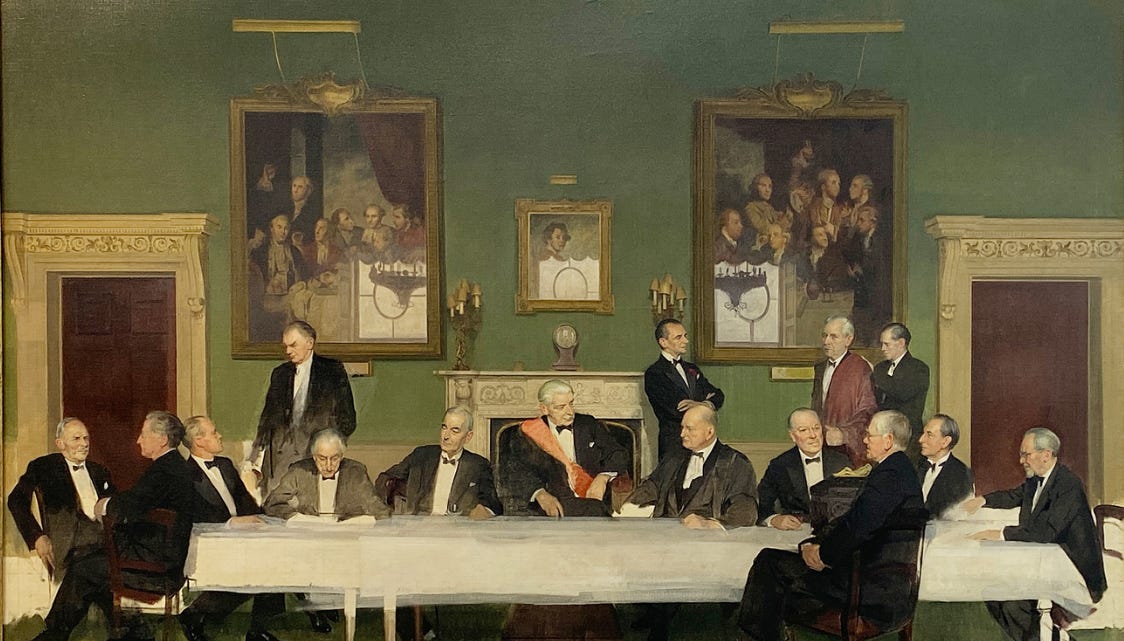The first of Sir Joshua Reynolds’ two group portraits, A Meeting of the Society of Dilettanti in 1777 (1777-80). From left to right: Sir Watkin Williams-Wynn, 4th Baronet, Sir John Taylor, 1st Baronet, Stephen Payne-Galway of Tofts Hall, Sir William Hamilton, Richard Thompson of Escrick Park, and Walter Spencer-Stanhope. (Picture credit: J. Mordaunt Crook and Charles Sebag-Montefiore (eds), Brooks’s 1764-2014: The Story of a Whig Club (London: Brooks’s, 2013), p. 134.)
The Society of Dilettanti was not a club in the sense of the organisations covered by this Substack. It never had its own premises (it did briefly plan some in the 1750s, though this was never realised), and it has met as a dining society. Yet for nearly three centuries, it has been an integral part of the Clubland landscape. And the mood of the Society is set by two prominent group portraits of its early members, painted by Sir Joshua Reynolds in the late 1770s, and displayed in the rooms where the Society has met.
The Dilettanti
The Society of Dilettanti is a group of English patrons of the arts; its founders had all originally met in Italy. The earliest surviving entry in its minute book describes a meeting at the Bedford Head Tavern in Covent Garden on 6th March 1736, pre-dating the conversion of White’s into a club; Jason M. Kelly believes it began as early as 1732, and became “more than just a dining society.” He writes:
“Unlike many other organisations in clubbable eighteenth-century London, the Society of Dilettanti formalised its meetings by recording its rules, membership list, minutes, and finances.”
The Society was made up of enthusiasts for 18th century Grand Tours, and was known for its interchange of appreciating classical culture and aesthetics (reflected in its motto ‘Grecian taste and Roman Spirit’) , sociability, elite masculinity, amateur archaeology - and bawdy conversation. (These days, the conversation is reportedly more tame.)
Horace Walpole famously provided a rather more cynical description, in a letter to Horace Mann on 17 April 1743:
“a club, for which the nominal qualification is having been in Italy, and the real one being drunk; the two chiefs are Lord Middlesex and Sir Francis Dashwood, who were seldom sober the whole time they were in Italy.”
At the outset, it made annual donations to the British Schools in Athens, Rome and Ankara - a tradition it continues to this day, along with annual donations to the British Museum and the Royal Academy. The Society has also funded archaeological expeditions in the past, with the first being to the Ionian coast of Asia Minor in 1764. They also published extensively around their expeditions, and Jason M. Kelly notes, “the Society of Dilettanti remained British leaders in the field of classical archaeology for some time.”
The Society met as a dining society in various venues for its first two centuries. From around 1757 until 1800, the Dilettanti met in a back room of the Star & Garter tavern on Pall Mall.
The collection of individual paintings of Dilettanti members by George Knapton, on display in Brooks’s since the 1970s. (Picture credit: Bruce Redford, Dilettanti: The Antic and the Antique in 18th-Century England (Los Angeles: J. Paul Getty Museum, 2008), endpapers.)
The Society of Dilettanti’s tradition of paintings
From its earliest days, the Society had a commitment to painting, and on 4th January 1741, it passed the following rule:
“That every member of the Society do make a present of his Picture in Oil Colours done by Mr. Geo Knapton, a member, to be hung in the Room where the said Society meets.”
George Knapton remained the Society’s painter until 1761, and it has retained an official painter (with the exception of the years 1925-53, when it could not agree on the appointment), with officeholders including Sir Thomas Lawrence, John Singer Sargent and David Hockney. Knapton’s original member portraits now line the library of Brooks’s.
To encourage members to have their portraits painted by the Society’s Painter, a system was instituted from 1745, of paying “Face Money” - an annual fine for every member who had not yet funded and donated an oil painting of themselves.
Reynolds’ group paintings
From 1769-92, the Society’s Painter was Sir Joshua Reynolds, already one of the foremost portrait painters of his day, as well as the founder and first President of the Royal Academy of Arts.
With the Society of Dilettanti ensconced in a back room of the Thatched House Tavern, Reynolds developed the idea of two large, complementary group paintings of members, each to hang over a mantelpiece at opposite ends of the room, and to serve as conversation pieces, and to provide atmosphere for meetings.
The second of Sir Joshua Reynolds’ two group portraits, A Meeting of the Society of Dilettanti in 1777 (1777-80). From left to right: 2nd Baron Mulgrave, Sir Thomas Dundas, 2nd Baronet (later 1st Baron Dundas), Kenneth Mackenzie, 1st Earl of Seaforth, the Hon. Charles Francis Greville, John Charles Crowle, Francis Osborne, Marquess of Carmarthen (later 5th Duke of Leeds), Joseph Banks (later 1st Baronet). (Picture credit: J. Mordaunt Crook and Charles Sebag-Montefiore (eds), Brooks’s 1764-2014: The Story of a Whig Club (London: Brooks’s, 2013), p. 135.)
Charles Sebag-Montefiore notes how:
“[Charles Robert] Leslie and [Thomas] Taylor [in their Life and Times of Sir Joshua Reynolds] in 1865 considered these two Reynolds groups to be among the painter’s masterpiece, reflecting the good taste and good cheer of the sitters.”
Less prosaically, Dilettanti member and art historian Richard Dorment gave the Daily Telegraph a disarmingly frank account of how the paintings blend the highbrow and the lowbrow:
“The first shows the collector Sir William Hamilton surrounded by seven of his fellow Dilettanti, pointing to an engraving of a Greek vase from his collection in the volume that lies open on the table in the foreground.
“In the second picture, seven more members of the society have gathered together to examine a collection of antique gems. If that makes the activities of the society sound deadly dull, read on.
“For not everyone in the pictures is giving these scholarly pursuits their fullest attention. In both paintings, wine is flowing, glasses are being clinked, and toasts are being proposed. After a while, the unworthy thought creeps into your head that perhaps these fellows aren't as high-minded as you'd assumed.
“Then, at last, the penny drops. In the first picture, most of the Dilettanti are paying only polite attention to Sir William's scholarly publication. Though the collector isn't aware of it, his colleagues are actually raising their glasses to a lady's garter that has been produced for general inspection by the fellow standing at the left.
“In the second picture, a young man holds a gem up to the light and in doing so makes a circle with his thumb and forefinger that his fellow Dilettanti would have recognised at once as a rude gesture signifying the female sex. Though the study of ancient gems seems like an innocent enough activity, among those that we know circulated among the Dilettanti was at least one cameo carved with a Dionysian orgy "not fit for a lady".
“Reynolds brilliantly captures both the serious and the frivolous sides of the Society of Dilettanti. At a time when royal and government patronage of the arts hardly existed, its members supported important expeditions to Greece and Iona, which resulted in publications that laid the groundwork for the development of archaeology as a serious scholarly discipline.”
The Society of Dilettanti in 1841, hosted in a back room of the Thatched House Tavern. Reynolds’ two group portraits can be seen hanging on the far wall. Engraving by J. H. Le Keux, after the original watercolour by T. H. Shepherd. (Picture credit: antique-prints.de.)
The Society of Dilettanti moves
As the Society of Dilettanti moved premises over the ensuing centuries, it took Reynolds’ two group portraits with it. In 1800, it first moved to Mr. Parslow’s tavern on St. James’s Street, then from 1810 to the Thatched House Tavern on the same street - an 1841 watercolour by T. H. Shepherd shows Reynolds’ two Dilettanti group portraits adorning the walls of the dining room during a Society dinner.
The Society later moved to Willis’s Rooms in King Street (formerly the premises of Almack’s) in 1861, where it remained until an 1890 move to the Grafton Galleries, on Mayfair’s Grafton Street.
Sir Herbert James Gunn, A Meeting at the Society of the Dilettanti of the St. James’s Club in 1954 (1954-9), showing the society when it was hosted in the St. James’s Club, with the dilettanti paintings visible on the wall. Members, left-right: (standing) Sir Victor Goodman, Sir Malcolm Sargent, 7th Duke of Wellington, Sir Herbert James Gunn, (seated) David Orsmby-Gore (later 5th Baron Harlech), 4th Baron Methuen, Viscount Hinchingbrooke (later 10th Earl of Sandwich), Louis Clarke, Sir Charles Travis Clay, Sir Dougal Malcolm, 6th Earl of Ilchester, 7th Earl Spencer, Sir Alan Barlow, 2nd Baronet, Sir James Mann and James Laver. (Photo credit: Artsy.net).
The Dilettanti at the St. James’s Club
After the Grafton Galleries changed owners in 1922 and were converted to a dance club, the Society of Dilettanti moved in with the St. James’s Club on Piccadilly, where it would remain for over half a century.
The Dilettanti’s tradition of commissioning paintings continued during this time, and included the commissioning of two group portraits of meetings at the St. James’s Club, by the then-Society Painter. The first, by Sir Herbert James Gunn, shows the two Reynolds group portraits in the background of a Dilettanti dinner in 1954.
The second, by John Stanton Ward, echoes the composition of Reynolds’ group portraits, albeit with a far more crowded roster of members. Depicting a meeting in 1973, it was not actually completed until three years later - one year after the St. James’s Club closed down. It therefore served as a tombstone for the end of an era.
Both sets of work now hang in Brooks’s.
A pair of complementary paintings, John Stanton Ward, A Meeting of the Society of Dilettanti in 1973, when it was based in the St. James’s Club (1973-6), and depicting 35 members in the bar. (Picture credit: J. Mordaunt Crook and Charles Sebag-Montefiore (eds), Brooks’s 1764-2014: The Story of a Whig Club (London: Brooks’s, 2013), pp. 140-1.)
The Dilettanti at Brooks’s
With the closure of the St. James’s Club, there followed a move to Brooks’s. Although this was widely misreported as being a formal merger/absorption, it was more of an informal arrangement of many former members of the St. James’s - further complicated by the Society of Dilettanti being organisationally independent.
Hanging the Reynolds portraits in the first-floor Subscription Room of Brooks’s was not uncontroversial. The decor had long shunned any paintings, with a preference to letting the architecture speak for itself, with its elaborate plasterwork, fireplaces, and barrel ceiling. (This was not an unusual attitude among earlier London clubs - the Travellers Club remained relatively denuded of paintings until the early 20th century for very similar aesthetic reasons, something reflected in early photographs of the building.) However, the Reynolds pictures found a home in the Club - not least as it was successfully argued that the year the paintings were completed was the same year that the room was completed.
The Society of Dilettanti has continued to meet at Brooks’s, some four or five times a year, for candle-lits members’ dinners in the Subscription Room, beneath the gaze of Reynolds’ group portraits. Membership is capped at sixty, although with some provision for up to six further honorary members.
Dorment recalls his induction at Brooks’s:
“All I can remember about my induction is being led in a candlelit procession into this magnificent room, which was dark except for flickering firelight. I then bowed to someone in red robes, who may or may not have been seated on a throne. For one alarming moment, an old friend dressed as a character called the Arch Master lunged at me with a drawn sword, but happily missed. I wish I could tell you that garters are still hoisted and toasted, but actually all that happened next was that a toast was drunk to my health.”
Richard Dorment in front of the first of the Dilettanti pictures in the Subscription Room at Brooks’s. (Photo credit: Geoff Pugh/Daily Telegraph.)
Further reading
Andrew Ballantyne, ‘Specimens of ancient sculpture: imperialism and the decline of art’, Art History, 25:4 (2002), pp. 550–65.
Lionel Crust (ed. Sidney Colvin), History of the Society of Dilettanti (London: Macmillan, 1898, rev. 1914).
Sir Brinsley Ford (ed. Charles Sebag-Montefiore), The Society of Dilettanti (Lingfield, Surrey: Lingfield Press, 1977, rev. 2005).
Sir Cecil Harcourt-Smith (ed. George A. Macmillan), The Society of Dilettanti, Its Regalia and Pictures (London: Society of Dilettanti, 1932).
John Ingamells (ed.), A Dictionary of British and Irish Travellers in Italy, 1701–1800 (New Haven: Yale University Press, 1997).
Jason M. Kelly, ‘Polite sociability and Levantine archaeology in the British Enlightenment: the Society of Dilettanti, 1732–1786’, PhD thesis, University of California, Santa Barbara (2004).
_____________, The Society of Dilettanti: Archaeology and Identity in the British Enlightenment (New Haven, Connecticut: Paul Mellon Centre, Yale University Press, 2009).
_____________, ‘The Society of Dilettanti’, Oxford Dictionary of National Biography (2006).
Bruce Redford, Dilettanti: The Antic and the Antique in 18th-Century England (Los Angeles: J. Paul Getty Museum, 2008).
_____________, ‘“Seria ludo”: George Knapton's portraits of the Society of Dilettanti’, British Art Journal, 3 (2001), pp. 56–68.
J. Mordaunt Crook and Charles Sebag-Montefiore (eds), Brooks’s 1764-2014: The Story of a Whig Club (London: Brooks’s, 2013).
Since 1972, the archives of the Society have been deposited with the Society of Antiquaries. In 1988, the archives for 1732-1900 were microfilmed, with copies of the microfilm deposited (and available for viewing) in the Royal Academy Library and the Ashmolean Museum, Oxford.
You can view the full and varied backlog of Clubland Substack articles, by clicking on the index below.
Index
Articles are centred around several distinct strands, so the below contains links to the main pieces, sorted by theme.











